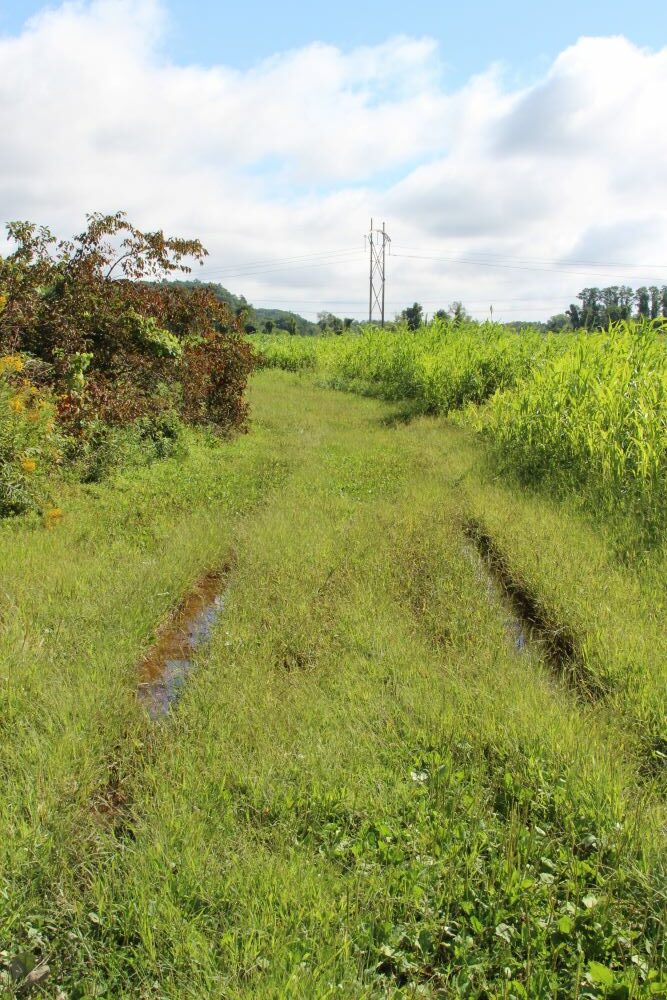
I remember it like it was yesterday. It is not an exaggeration to say it changed my life forever, particularly in the sense of how, as a wildlife biologist, I have come to think about the biodiversity found in small puddles and the habitat such puddles provide. It was July of 2021. Dr. Erik Kiviat, the executive director of Hudsonia was at the farm sampling aquatic life found in different seasonal pools and puddles. The visit was for a project he had been working on in the region with his colleague Dr. Bob Schmidt, associate director of Hudsonia. I ran into Erik near the end of his visit that day and he excitedly proclaimed he had observed clam shrimp in a shallow tire track rut filled with water in one of the dirt farm roads. I have known Erik long enough to know that, based on the twinkle in his eye and his enthusiasm; this was something I needed to find out more about. I shared in his excitement but also wondered, what is a clam shrimp? Erik went on to explain that clam shrimp, depending on the species and their age, are often only 2 – 5 mm in length. They are a type of shrimp-like crustacean that, while they possess a shell that looks almost identical to a clam, are not closely related to clams.
A number of clam shrimp species tend to live in habitats such as the small Farm Hub rain puddle. The puddles frequently dry up entirely and then fill again during rain events. Not all clam shrimp species live in this way. Bob later shared with me that it is important to note that some species of clam shrimp require water that is more permanent as well as longer time periods to mature than the Farm Hub puddle-dwelling species. He had identified the Farm Hub clam shrimp as being in the genus Eulimnadia. It is possible that the species is Eulimnadia diversa, however one has to look at the patterns on the outside of the eggs to determine the species which can be a challenge.

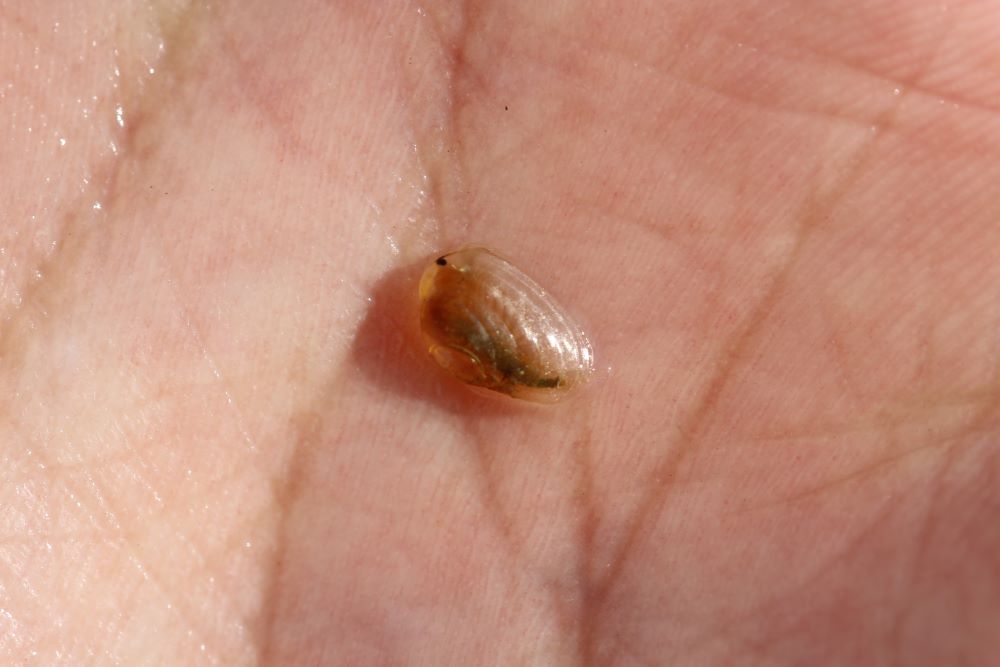
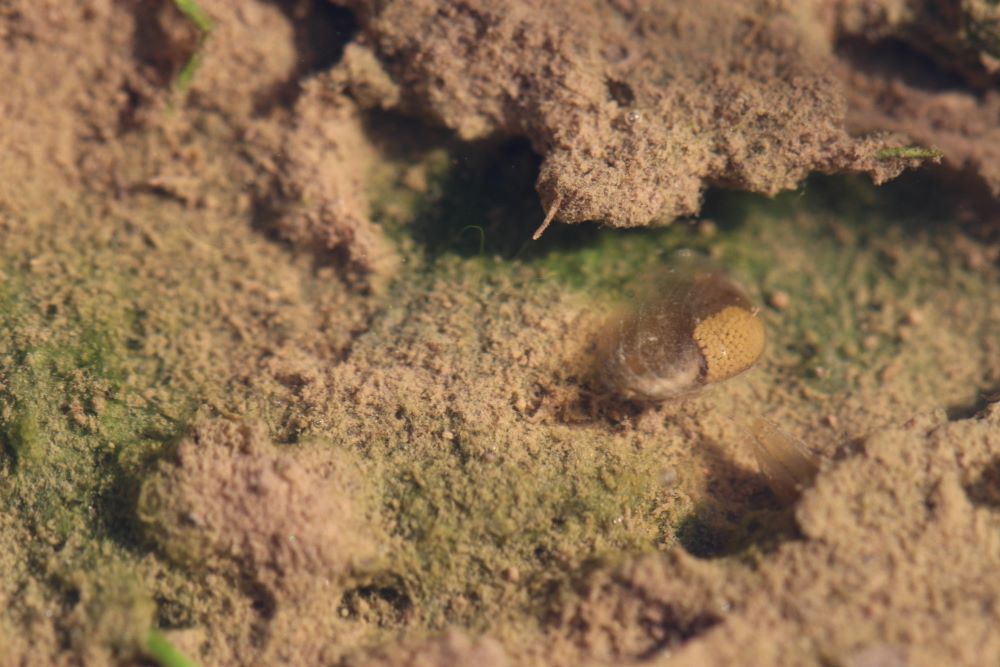
Clam shrimp distribution and life cycle
Much remains unknown about the distribution of clam shrimp in New York, though some of the recorded observations that do exist have also documented them in similar small ephemeral rain puddles in roads. In New York State and elsewhere, it is uncertain if clam shrimp are actually rare or if they simply are not documented very frequently. It is possible that clam shrimp are under surveyed and a more robust sampling effort would result in more widespread observations (Schmidt et al., 2018). Clam shrimp have what are known as “resting eggs.” The eggs are able to tolerate conditions such as drying out, heat, cold and freezing. Little is known about how clam shrimp disperse from one area to another. An organism that looks like a shrimp, swims around with a clam shell and by some means disperses to puddles that can completely dry up? I wanted to see them, but their lives are incredibly fleeting. The nature of the habitats they use are quite ephemeral – a rain filled puddle could be completely dry in a matter of days. By the time I went to see the clam shrimp, they were gone. Erik mentioned to keep an eye on the puddle and, if we had another good rain, to continue to observe it for several days. In some cases, there can be several broods of clam shrimp in a season.
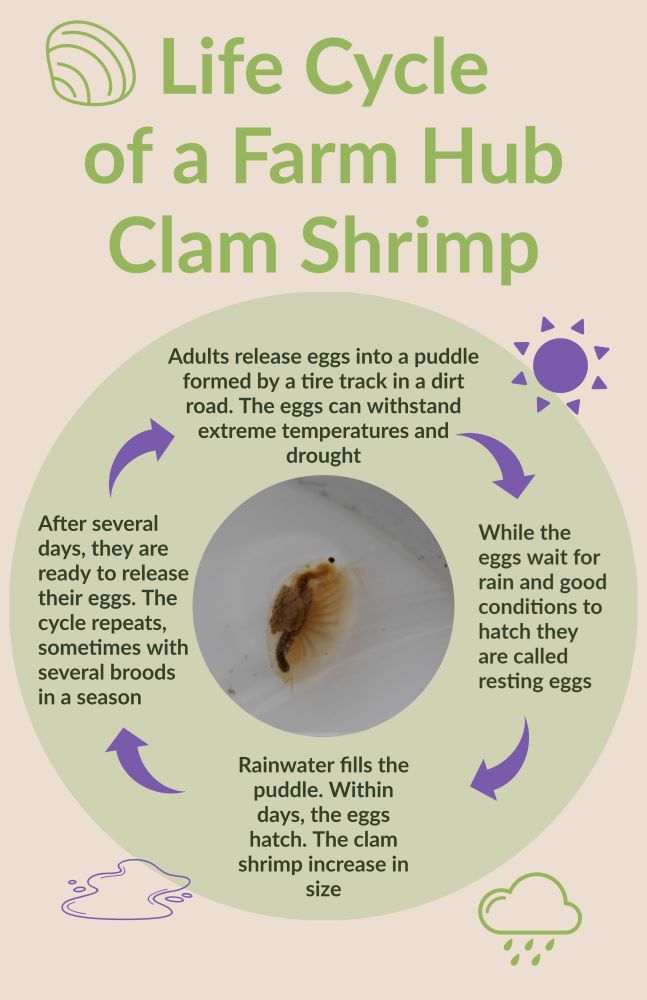
There is a detail worth noting here. If you look up “clam shrimp” in the literature or on the internet, Bob and Erik’s names come up readily. As a trout angler and the daughter of a limnologist, I know a number of folks passionate about aquatic creatures. But I have never met two people more enthusiastic and passionate about aquatic invertebrates as Erik and Bob. If you want to learn about clam shrimp, they are the people to ask. The fact that I was able to learn about clam shrimp firsthand from them was wonderful and something I will be forever grateful for.
The days ticked by and there were no signs of the clam shrimp. Paige Cranfield, the Assistant Farm Manager and I would visit the puddle; being bit by mosquitos, straddling the puddle until we felt dizzy, hoping for a sign. It is safe to say we were not even entirely certain what exactly to look for. I remember wondering if we would even recognize them if they were right in front of us. But we kept looking nonetheless. Finally, we saw them. On August 30, 2021, we approached the puddle just as before. As we peered into the puddle our eyes focused. Movement. But what? We looked closer and there they were. Little pinky nail-sized clam shrimp, swimming about busily going about their day. As we looked closer, we saw their thin, shrimp-like bodies pressed up against the “hinge” of their shells. As we watched, we noticed many of them were carrying eggs inside their translucent shells. We screamed, both in shock and delight. They were here! It’s interesting how quickly one can become invested in the lives of creatures so different from our own species. But there they were, eating, resting, moving, interacting, in a world seemingly so foreign yet in many ways familiar to our own daily lives.
A timeline of the clam shrimp life cycle
For almost a year, a sticky note sat quietly on the wall in my office reminding me when we had seen the clam shrimp in 2021. Then, on the evening of July 13, 2022 a powerful storm blew in with rain, hail and strong winds. I vividly remember about six hours before the storm hit, Paige looked up at the sky with a certain intuition that only years observing the weather can bring. All she said was, “huh, that’s interesting”. I looked too, trying to glean the meaning. There was hardly even a forecast for rain that evening. The storm produced widespread damage in Kingston, Hurley and Marbletown and the hills just to the north and west of the Esopus Creek. People at the Farm Hub reported sideways, driving rain and ominous swirling clouds. Leaves were stripped from trees and crops were damaged by hail. Trees lined the roads like piles of matchsticks. According to the National Weather Service, the damage was surveyed and it was determined that a tornado had touched down with an estimated peak wind of 90 miles an hour traveling about 300 yards a couple miles west of Kingston near Hurley Avenue. A stone’s throw from the clam shrimp puddle.
The following day I arrived at the farm. Trees were down everywhere and the power was out. “Clam shrimp.” A distant memory swirled from the depths of my thoughts. We checked the puddle, surveying the damage along the way. The water was murky and stained from the rain with no clam shrimp. Five days following the storm was a completely different story. The puddle was clear and calm and it teemed with small clam shrimp. They returned! Or, did they ever really leave? One can see how observations of clam shrimp are uncommon. Even if you know when and where to look, they are only observed for a small number of days until the cycle repeats. Over the next few days, the clam shrimp grew in size and their shells appeared more substantial. Despite several inches of rain and a full puddle, July 22 was the last day we saw them. On July 26, the puddle had been driven through and the clam shrimp were not observed. On September 19, Erik and Bob checked the puddle for the final time. No clam shrimp. Were we not there at the right time to see a second brood as we did last August? Was there never a second brood? This will remain a mystery.
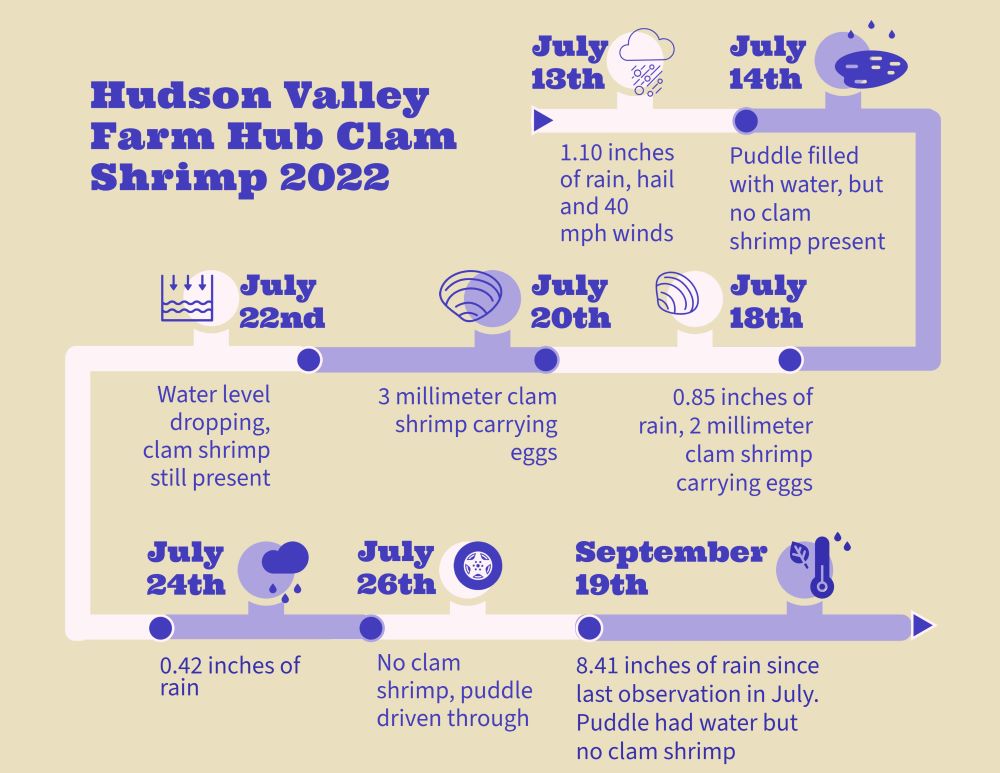
A detailed description of the puddle in July
A number of different people stopped by to see the clam shrimp. One such person was Bob Miller. I know Bob first and foremost as a skilled and enthusiastic birder. He is also a talented photographer and naturalist. Bob is a volunteer for the Farm Hub, conducting bird habitat use surveys as part of our long-term monitoring at the farm. The clam shrimp puddle happened to be on his survey route and I excitedly mentioned to him that he must go to the puddle to observe them. I will include Bob’s observations here both for posterity as well as to note the peculiar similarities in the way we both described the clam shrimp.
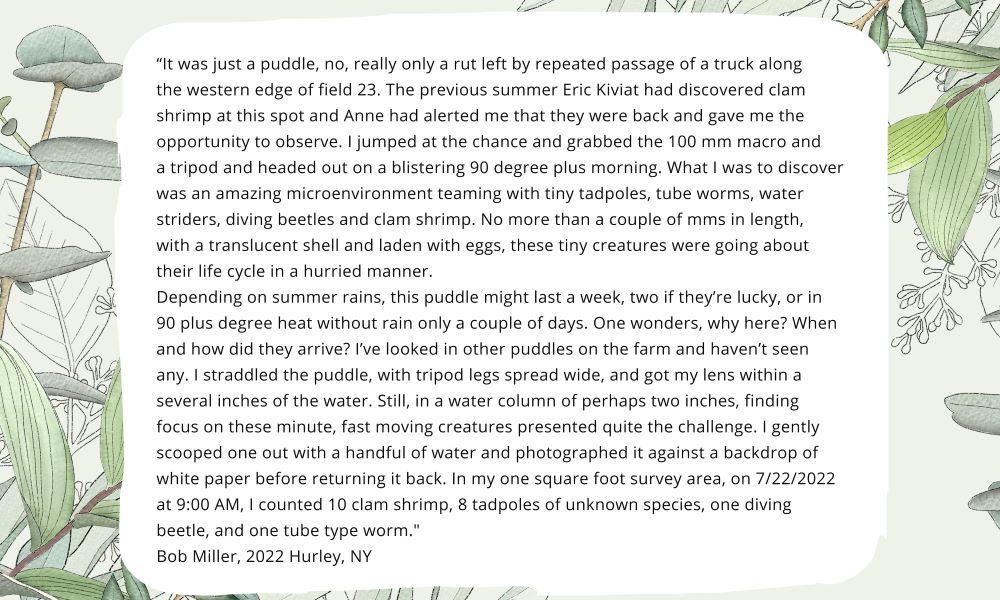
Biodiversity conservation of clam shrimp and rain puddles
It should be noted that, while some temporary waters are protected by wetland regulations, rain-puddle habitat on or along unimproved roads has no such protection (Schmidt et al., 2018). At the Farm Hub, there are times at which we must prioritize fixing a farm road due to the protection of people and farm equipment. With that said, since the documentation of clam shrimp in 2021, as an organization we do now take into consideration small-puddle dwelling organisms when possible. While we have repaired some areas of the farm roads, the puddle where the clam shrimp reside has remained as is. Ironically it is the driving through the puddle that formed it in the first place. So, we do not intend to restrict driving activity there. What Bob and Erik do recommend generally is that dirt roads one year or more old with long-lasting rain puddles > 1 m2 and> 5 cm deep be checked for clam shrimp during June-September as part of land management or environmental review processes. In addition, they recommend that “conservation biologists and environmental planners….pay more attention to organisms such as clam shrimp and the artificial or altered habitats that support them. Altered or artificial habitats of types known to support rare organisms should be surveyed for those species routinely, much as natural and semi-natural habitats are surveyed for rare species” (Schmidt & Kiviat, 2007).
Of course, one could technically come up with a complex “puddle management plan” where we drove through the puddle a certain amount of times at different times of year and placed barricades around the puddle when clam shrimp were active. But I do think sometimes as wildlife biologists we can get caught up in being active instead of pragmatic and efficient habitat managers. Whatever has been happening in those fields has allowed for the presence of clam shrimp. That said, management could potentially include some level of controlled motor vehicle activity to maintain the puddle habitat and potentially disperse clam shrimp, should that be confirmed as a mode of effective dispersal (Schmidt & Kiviat, 2007). Regular field activities created the conditions that brought clam shrimp in. Our strategy now is to steward the habitat to the extent that it remains in good condition, while allowing field activities to continue. In the absence of a widespread regional land stewardship culture that includes emphasis on how to best support and protect the biodiversity found in these often overlooked habitats, we will continue to do our best, with Erik and Bob’s support, to create conditions for people, crops and clam shrimp to all thrive.
What do clam shrimp have to do with the food system?
I was reflecting on all of this today and had a funny thought, “a farmer plants beans and a clam shrimp is born”. When we nourish ourselves at our tables, most of us do not express gratitude for the tire rut puddles the farmers created while managing the crop fields for our food. But maybe we should? We are all inextricably linked in an ecological web of interconnections. We all come from many different paths, life experiences, professions, cultures and perspectives. And we all play a part in shaping these complex interconnections of land, food, people and creatures.
A number of people contributed to Farm Hub clam shrimp observations and documentation. Thank you to: Bob Schmidt, Associate Director, Hudsonia; Erik Kiviat, Executive Director, Hudsonia; Teresa Dorado, Ecology Program Coordinator, Farm Hub, Paige Cranfield, Assistant Farm Manager, Farm Hub and Bob Miller, Volunteer, Farm Hub. To read two of Bob Schmidt and Erik Kiviat’s papers, see the links below.
References:
